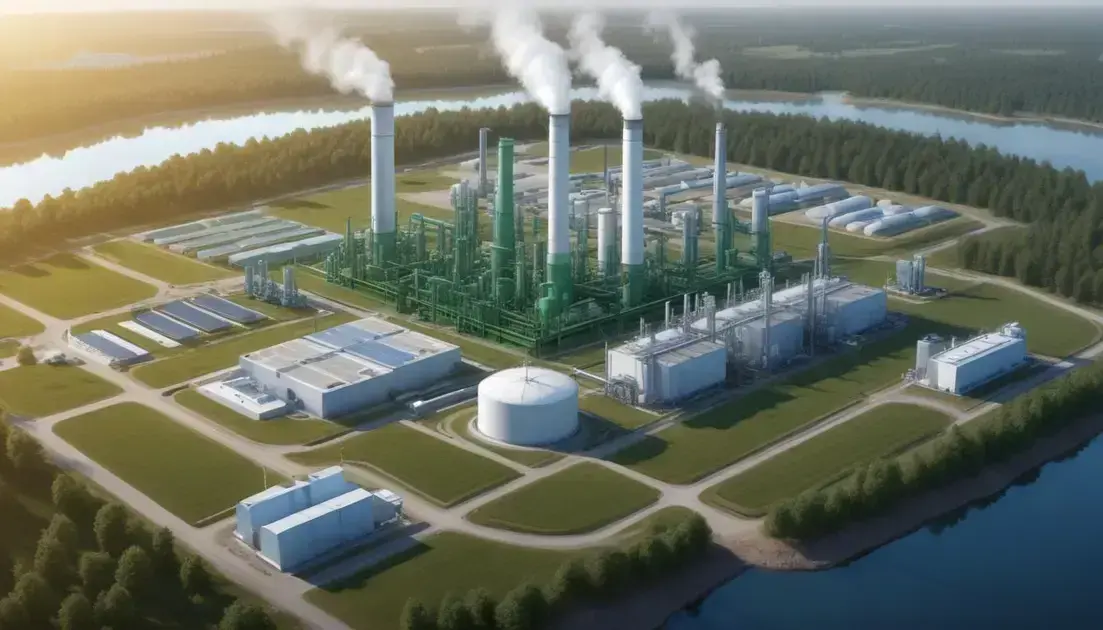Hydrogen’s Bright Future in Sustainability
Hydrogen is a crucial element in sustainability efforts, helping to reduce carbon emissions and enabling cleaner energy solutions across various industries, particularly as investments and technology advancements continue to grow.
In the quest for sustainability, hydrogen emerges as a key player. Its potential to reduce emissions is substantial, but challenges do remain. What does the future hold for this promising energy source?
Hydrogen’s Role in the Green Transition
Hydrogen is increasingly viewed as a cornerstone in the green transition, offering a cleaner alternative to fossil fuels. By harnessing hydrogen, we can significantly reduce carbon emissions and combat climate change effectively. When generated through renewable sources, hydrogen becomes a sustainable energy carrier that can power homes, industries, and transportation systems.
The production methods for hydrogen are evolving, with green hydrogen—produced via electrolysis powered by renewable energy—gaining momentum. This process produces zero emissions, making it a vital component in achieving net-zero goals.
Moreover, hydrogen plays a crucial role in hard-to-abate sectors, such as steel manufacturing and heavy-duty transport. Its versatility allows it to be used in fuel cells, which can energize vehicles and machinery without polluting the atmosphere. This adaptability makes hydrogen essential in transitioning various sectors towards sustainability.
Investments in hydrogen infrastructure are growing, as nations recognize the need for policies and frameworks to support its development. Governments and private sectors are collaborating to foster innovations that will make hydrogen more economically viable and accessible.
Current Challenges in Hydrogen Implementation
Despite its promising potential, the implementation of hydrogen technology faces several challenges. One significant hurdle is the cost associated with hydrogen production, particularly for green hydrogen. Electrolysis, the primary method for sustainable hydrogen production, requires substantial investments in renewable energy sources and infrastructure.
The storage and transportation of hydrogen also present logistical challenges. Hydrogen has a low energy density, making it difficult to store and move efficiently. Developing effective storage solutions and transport networks is crucial for widespread adoption, as existing pipelines often cater to natural gas rather than hydrogen.
Another challenge lies in the technological maturity of hydrogen fuel cells. While advancements are being made, many fuel cell technologies still require further development to ensure reliability and efficiency for various applications, from vehicles to industrial processes.
Furthermore, regulatory and safety concerns can impede progress. Hydrogen is highly flammable, necessitating robust safety protocols and regulations to protect workers and the public. Addressing these safety concerns is vital to fostering trust in hydrogen technologies and their implementation.
Investment Trends in the Hydrogen Sector
The hydrogen sector is witnessing a surge in investment as the world pivots towards cleaner energy solutions. Investors, motivated by sustainability goals and profitability, are increasingly funding projects related to green hydrogen production. This shift reflects a growing recognition of hydrogen’s potential to decarbonize several industries.
Government policies play a crucial role in shaping investment trends. Subsidies, incentives, and initiatives aimed at promoting clean energy are attracting significant private capital. Governments worldwide are committed to establishing frameworks to boost hydrogen innovation and infrastructure.
Public and private partnerships are becoming common in the hydrogen sector, helping mitigate risks associated with large-scale projects. These collaborations often expedite research and development, leading to technological advancements and reduced costs.
Moreover, venture capital is flowing into hydrogen startups focused on innovative solutions, from production techniques to hydrogen transportation technologies. The competition in this space fosters creativity and can lead to groundbreaking advancements that enhance the feasibility of hydrogen as an energy source.
As the demand for renewable energy grows, the hydrogen market is projected to expand, creating new investment avenues. With the right strategies and collaboration, the hydrogen sector stands poised for considerable growth in the coming years.
The Impact of Geopolitical Forces on Hydrogen
The hydrogen sector is significantly influenced by geopolitical forces, which can shape investment patterns and regulatory frameworks. Nations rich in renewable energy resources are increasingly positioned to lead the hydrogen market. For example, countries like Germany and Australia are making substantial investments to develop hydrogen infrastructure, leveraging their natural advantages to gain a competitive edge.
Trade policies and international relations also play a crucial role in the global hydrogen economy. As countries pursue energy independence, they often prioritize domestic hydrogen production over imports. This shift can lead to increased competition among nations to secure technology and resources necessary for hydrogen development.
Additionally, diplomatic agreements can facilitate collaborations in hydrogen research and production. For instance, partnerships between countries can accelerate innovation and help establish global standards for hydrogen technologies. These collaborations allow nations to share knowledge and resources, ultimately enhancing the reliability and scalability of hydrogen solutions.
However, geopolitical tensions can pose challenges as well. Disruptions in trade relationships may hinder access to critical technologies or materials needed for hydrogen production. Understanding these dynamics is essential for stakeholders in the hydrogen market as they navigate opportunities and risks in a rapidly evolving landscape.
Future Outlook for Hydrogen in Sustainability
The future outlook for hydrogen in sustainability appears promising as advancements in technology and increasing investment pave the way for its broader adoption. As nations commit to net-zero emissions goals, hydrogen is being recognized as a crucial element in the transition to cleaner energy systems. Its versatility allows it to play multiple roles, from storage solutions to fuel for transportation.
Innovation in production methods is key to unlocking hydrogen’s potential. The continued development of green hydrogen technologies, primarily produced from renewable energy sources, is expected to drive down costs and increase production efficiency. This progress may lead to greater market acceptance and expand hydrogen’s application across various sectors.
Moreover, the implementation of supportive government policies will be vital in creating a conducive environment for hydrogen initiatives. Financial incentives and research grants can accelerate the commercialization of hydrogen applications and foster public-private partnerships.
As infrastructure for hydrogen distribution expands, there will be an increased potential for hydrogen to replace fossil fuels in hard-to-decarbonize industries. This shift will not only help meet climate targets but also create job opportunities and stimulate economic growth in emerging green sectors.
In summary, the future of hydrogen in sustainability
is bright as it plays a vital role in the transition to cleaner energy. Hydrogen offers solutions to reduce carbon emissions across many industries.
With ongoing advancements in production technologies and increased investments, hydrogen can become more accessible and affordable. Government policies supporting hydrogen initiatives will further drive this change.
As infrastructure expands and new applications emerge, hydrogen is set to replace fossil fuels in challenging sectors. This evolution will help meet climate goals and contribute to economic growth.
Embracing hydrogen technology today can lead to a more sustainable and prosperous future for all.
Frequently Asked Questions
What are the main benefits of hydrogen as a sustainable energy source?
Hydrogen helps reduce carbon emissions, can be produced from renewable resources, and is versatile enough to be used in various sectors, including transportation and industry.
How is green hydrogen produced?
Green hydrogen is produced through electrolysis, where water is split into hydrogen and oxygen using electricity generated from renewable sources, such as wind or solar power.
What challenges does hydrogen face for widespread adoption?
Challenges include high production costs, the need for infrastructure development for storage and transportation, and safety concerns due to its flammability.
How can government policies support hydrogen development?
Governments can offer subsidies, tax incentives, and research grants to encourage investments in hydrogen technologies and infrastructure.
What role does hydrogen play in hard-to-abate sectors?
Hydrogen can replace fossil fuels in sectors like steel manufacturing and heavy transportation, providing a cleaner alternative for decarbonization.
What is the future outlook for hydrogen in sustainability?
The future looks promising, with increasing investments, advancing technologies, and expanding infrastructure, making hydrogen a key player in achieving sustainability goals.






